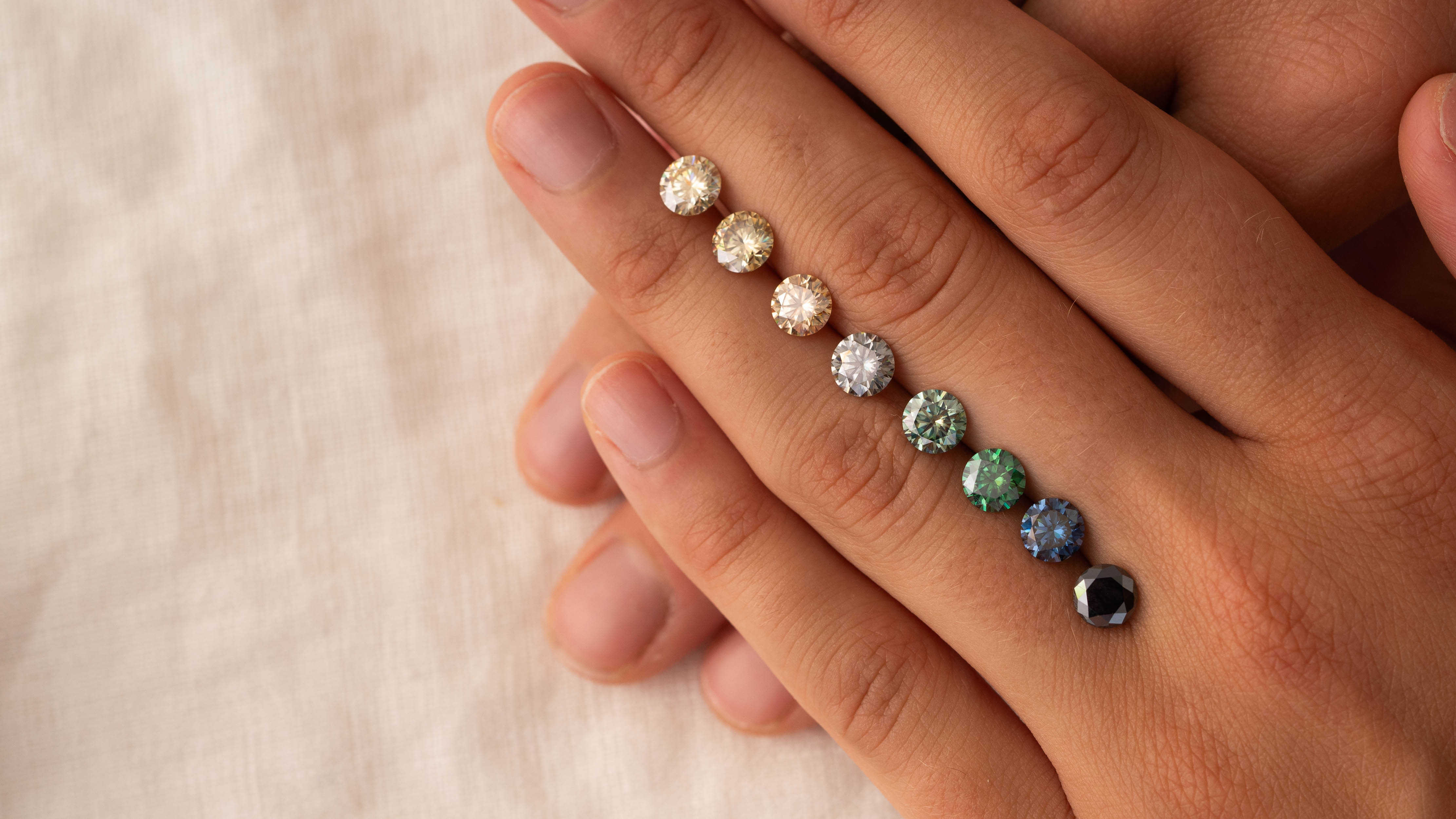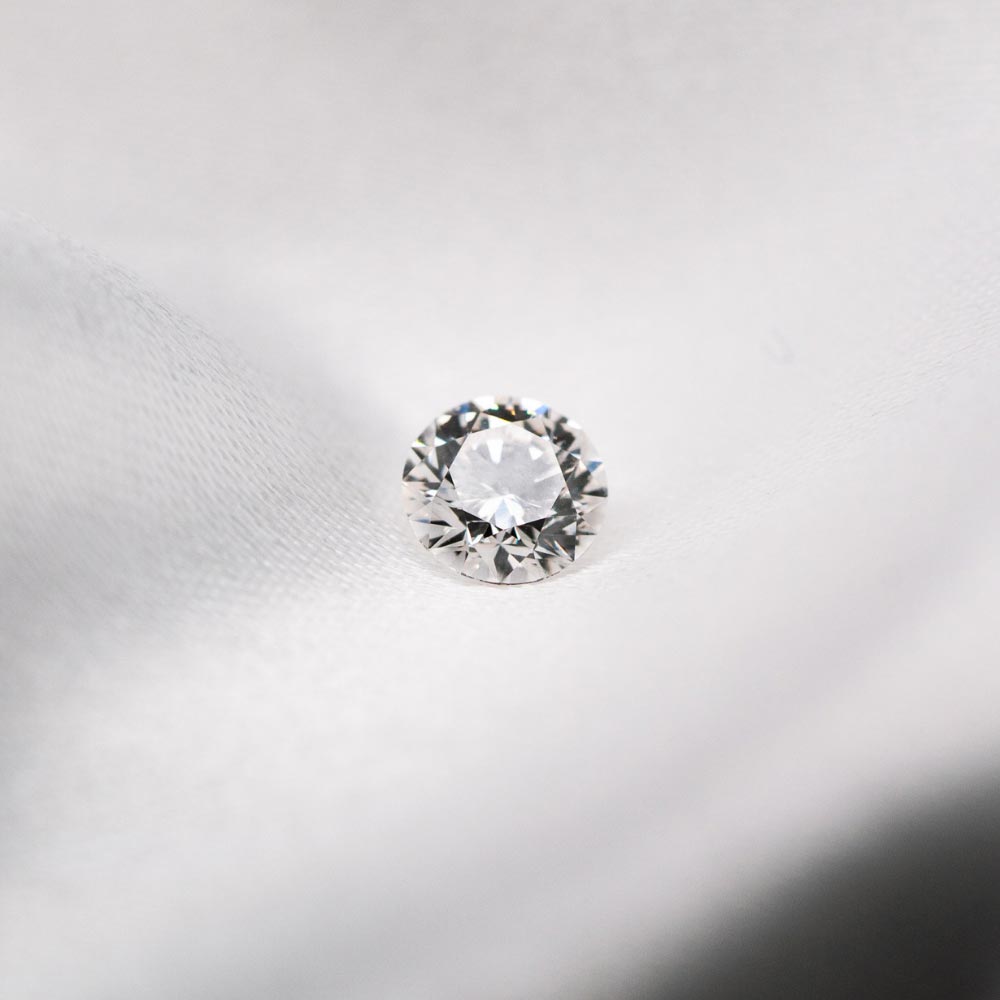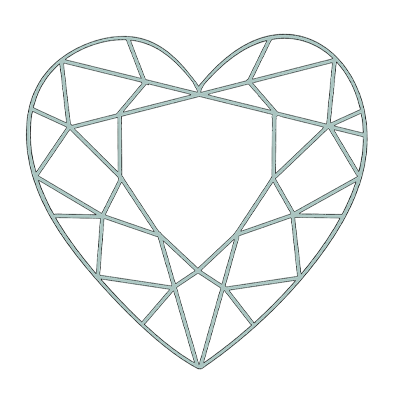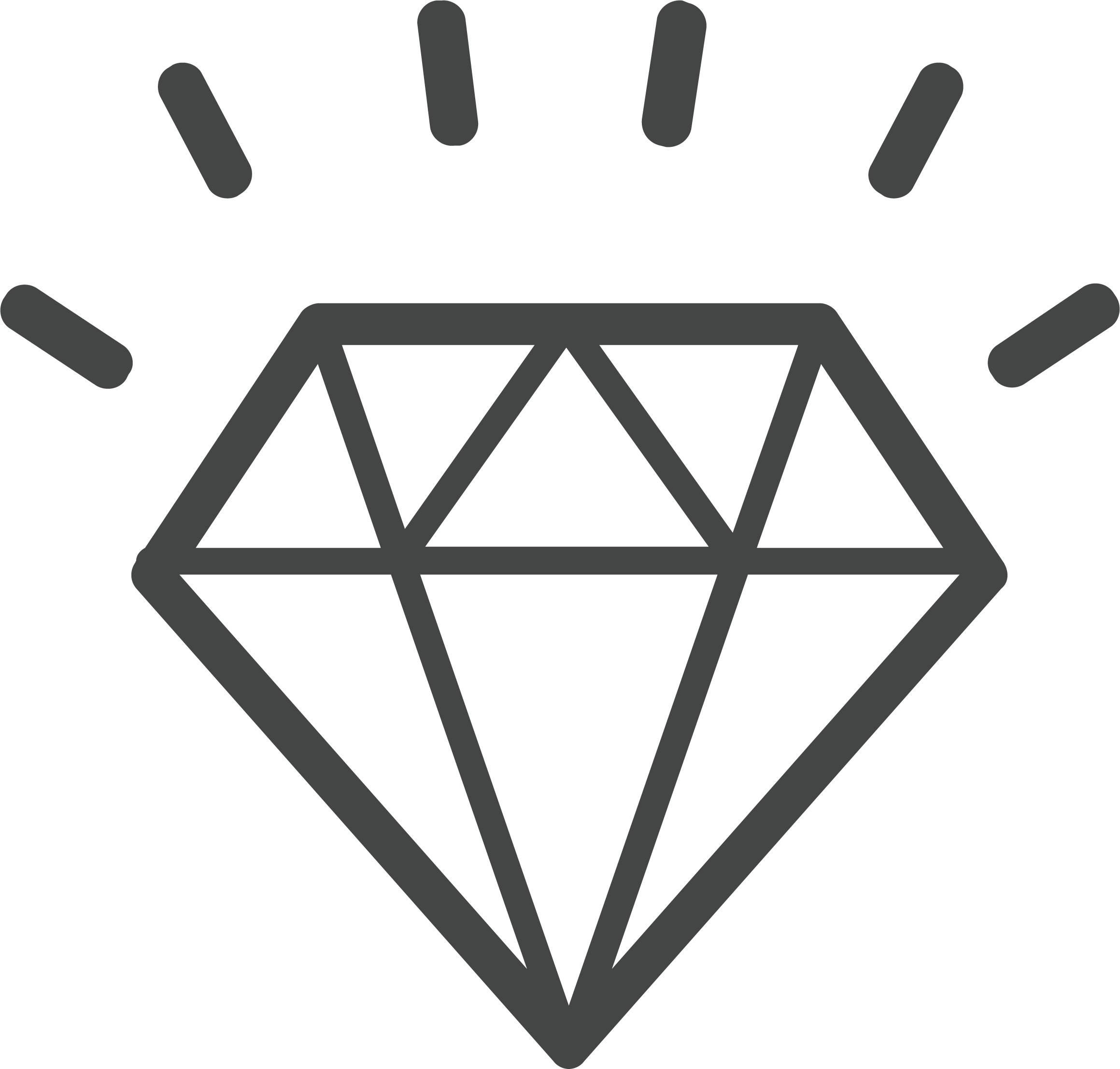What is the Ethica Diamond®?
The Ethica Diamond is our signature gemstone. It is a super premium grade moissanite with a diamond infusion, which sets it apart from standard moissanite.
The Ethica Diamond has very similar strength, durability and scratch resistance (hardness) to diamond on its surface due to its diamond infusion, with the benefit of being considerably less expensive than lab and natural diamonds.
It is also the only super premium moissanite to be independently certified by the IGI, the World's largest Independent Laboratory for testing and Grading Gemstones and Fine Jewellery.

Coloured Ethica Diamonds
The Ethica Diamond® is also available in other colours, such as blue, champagne, aqua, green, grey and black and they are more durable than standard lab grown coloured gemstones.

What is Moissanite?
Moissanite is a gemstone born from the stars. Microscopic particles of the gem were discovered by scientist and Nobel Prize winner Henri Moissan in 1893 in Arizona, in a crater created by a meteorite which fell to Earth. Naturally occurring moissanite is incredibly rare (far rarer than diamond, in fact!), so nowadays moissanite is grown in a laboratory under strict conditions. This gemstone is now one of the world’s most scintillating gems and it can be grown to a quality that is suitable for setting within jewellery.
Due to its similar composition and atomic structure, the characteristics of moissanite are similar to diamond. They are usually cut and polished to mimic diamond proportions and brilliance. For this reason, moissanite falls under the category of diamond simulants, created to give the illusion of some of the finest natural diamonds without being chemically identical. We will explore the key differences below.
“Ethica Diamonds radiate breathtaking sparkle & brilliance and are made to last forever, to be passed on through the generations, without carrying the high cost and environmental toll associated with natural mined diamonds.”
Ethica
Diamond®

Diamond

DURABILITY
The Ethica Diamond has a hardness of 9.7 due to the diamond infusion. Standard moissanite is 9.25 Mohs. Both are very durable and suitable for everyday wear.
Diamond is the hardest known mineral with the highest rating on the Mohns scale of 10. It is very durable and ideal for everyday wear.
BRILLIANCE
Moissanite has more fire and brilliance than diamond, and in fact any other gemstone, meaning that it exhibits more colourful “rainbow” flashes. It is double refractive which means that although it sparkles more than diamond, the facets are not as “crisp”.
An exception to this is a round brilliant moissanite with a Hearts and Arrows cut. An Ethica Diamond with this H&A’s cut is specifically cut to mimic the brilliance of diamonds as closely as possible. The difference in brilliance between a diamond and an Ethica Diamond with this H&A’s cut is much less noticeable, making it a good choice for mimicking a diamond more closely.
Diamonds have a slightly different brilliance to moissanite. Diamonds also have fire, brilliance and scintillation but they reflect more white light than moissanite, and they don’t refract as many colours as moissanite. They are not double refractive, which means the facets look crisp and clean.
The cut of a diamond is very important when determining how much light is reflected out of the stone and into the eye, which is why a diamond should have an excellent or ideal cut for it to sparkle the way it should.
COLOUR
Ethica Diamonds are colourless, since they fall between D-F on the scale with an E colour. Warmer colours are also available, as well as “fancy” coloured Ethica Diamonds.
A colour which falls within the “colourless” grade means that the gem has a natural body colour which contains no traces of yellow, brown or grey, resulting in a dazzling bright white appearance.
Diamonds, lab or natural, can be graded at any point along the colour scale, ranging from:
Colourless (D-F),
Near Colourless (G-J),
Faint Yellow (K-M),
Very Light Yellow (N-R), Light Yellow (S-Z).
Fancy colour diamonds are graded on a different scale and are referred to as “Fancy”.
CUT
Every Ethica Diamond is cut and polished by hand to Excellent cut diamond proportions, giving each stone incredible sparkle, similar to diamonds with the same cut quality.
The cut of a diamond is the most important factor for determining the beauty of the stone. Ensuring a diamond has a cut that is graded as Excellent or Ideal will give you a truly beautiful diamond that sparkles beautifully.
CLARITY
Every Ethica Diamond has an independent clarity grade of VVS1-IF. This ensures the durability of the gem is at its best. Inclusions cause weaknesses, making it more vulnerable to chipping, as well as distracting from a gem’s sparkle.
The clarity of diamonds can vary greatly.
Similarly to moissanite, it is important to choose a diamond with a good clarity to ensure its structural integrity, as well as having no flaws within the stone which can distract from the sparkle.
PRICE
The Ethica Diamond is less expensive than lab and natural diamonds. This makes them a great consideration for those who want a gem with a large carat weight for a budget that is more accessible.
The Ethica Diamond is a Super Premium grade moissanite. This grade is more expensive than the other Standard and Premium grades.
1.0ct - £600 (Ethica Diamond)
2.0ct - £1,200 (Ethica Diamond)
3.0ct - £1,800 (Ethica Diamond)
Diamonds vary greatly in price depending on their specifications and certification. A diamond with the same specifications and carat weight as the equivalent Ethica Diamond is generally at least double the price. The price difference increases as the carat weight increases.
1.0ct - £1,030* (lab diamond)
2.0ct - £3,210 (lab diamond)
3.0ct - £8,570 (lab diamond)
SOURCING
The Ethica Diamond is lab created, as is the case for all moissanite these days (naturally occurring moissanite is incredibly rare). This makes the origin very easy to trace since they don’t require mining, making them an appealing choice for those wanting a socially ethical choice for a gemstone.
Diamonds can either be natural or laboratory grown. In the case of natural diamonds, the vast majority require mining which cannot be guaranteed to be fully traceable despite attempts through the kimberley process or blockchain.
Lab grown diamonds can be traced to the laboratory where they were grown and they don’t require mining.
The energy used to grow them determines how environmentally friendly they are. Read more about environmentally friendly lab diamonds here.
How does the Ethica Diamond® compare to standard Moissanite?
MOISSANITE

ETHICA
DIAMOND

HARDNESS
9.2 Mohs
9.7 Mohs
DIAMOND INFUSION
No
Yes
QUALITY
Standard - poor quality and finish
Premium - good quality and finish
Diamonds, lab or natural, can be graded at any point along the colour scale, ranging from:
Colourless (D-F),
Near Colourless (G-J),
Faint Yellow (K-M),
Very Light Yellow (N-R), Light Yellow (S-Z).
Fancy colour diamonds are graded on a different scale and are referred to as “Fancy”.
COLOUR
Standard - H or below, often with a yellow or green tinge
Premium - nearly colourless G-H colour
Diamonds, lab or natural, can be graded at any point along the colour scale, ranging from:
Colourless (D-F),
Near Colourless (G-J),
Faint Yellow (K-M),
Very Light Yellow (N-R), Light Yellow (S-Z).
Fancy colour diamonds are graded on a different scale and are referred to as “Fancy”.
CLARITY
Standard - generally available in VS or above
Premium - VVS
Diamonds, lab or natural, can be graded at any point along the colour scale, ranging from:
Colourless (D-F),
Near Colourless (G-J),
Faint Yellow (K-M),
Very Light Yellow (N-R), Light Yellow (S-Z).
Fancy colour diamonds are graded on a different scale and are referred to as “Fancy”.
AUTHENTICITY
Standard - often uncertified. Caution should be taken for uncertified stones. Without independent authentication, it cannot be guaranteed the colour and clarity of the gem is true.
Premium - Usually independently certified or approved by a gemmologist.
Independently certified and laser inscribed by the GRI or IGI - the world's largest Independent Laboratory. The Ethica Diamond is the only super premium moissanite to be certified by the IGI.
WARRANTY
Standard - usually no warranty.
Premium - may have a warranty, depending on the brand.
Lifetime warranty
Moissanite vs Diamond FAQs
What is moissanite?
Moissanite is a very rare naturally occurring mineral, with the chemical name silicon carbide, which was discovered in a crater in Arizona formed by a meteorite. The name moissanite was given to honour the Nobel Prize-winning chemist Dr. Henri Moissan, who first discovered the gem.
Can you tell the difference between moissanite and diamond?
Yes, but it is not without difficulty to the untrained eye. Moissanite has more fire than a diamond, meaning that when light passes through the gem, it reflects a rainbow of colours. Moissanite has more brilliance than a diamond as well, meaning that it sparkles more. A diamond with a good quality cut (excellent or ideal) will appear more “crisp” as a result.
Is the Ethica Diamond® moissanite?
Our signature gemstone, the Ethica Diamond, is precisely cut from premium grade silicon carbide (moissanite) with a diamond infusion and is independently certified by the IGI or GRI. Silicon carbide has a hardness rating of 9.7 Mohs, and with the diamond fused on the surface, the outer hardness is 10 Mohs (the scale of hardness and scratch resistance), which is the same as diamond. They are faceted and hand polished by trained diamond cutters in the same way diamonds are cut, which imitates the appearance of diamond very closely. Even jewellers may struggle to tell the difference.
How is the Ethica Diamond® different from standard moissanite?
The Ethica Diamond is the only moissanite available that is produced using patented technology.
This super premium grade moissanite is cut and polished to exact diamond proportions and then CVD diamond is grown at an atomic level directly to the surface area of the silicone carbide (moissanite). This treatment adds benefits to standard moissanite gemstone which include:
- Enhances the surface hardness to 10 on the Mohs scale of scratch resistance, which is the same as diamond. This increases durability.
- Enhances the overall look of standard moissanite, giving it a more adamantine lustre, more comparable to diamond.
- This is the only moissanite to be graded by the IGI, which is reflective of the quality of the stone. The IGI is a world renowned independent grading institute for diamonds (both natural and lab grown).
Please note that the option to upgrade to an IGI certificate is currently only available for the round brilliant Ethica Diamonds.
Why is your moissanite called The Ethica Diamond®?
It was the very first alternative to diamond we used in our jewellery, long before lab diamonds had even reached the UK market, and we have always been the only distributors for this gemstone in the UK - hence the name!
Is moissanite suitable for an engagement ring?
Yes, absolutely! A good quality (Super Premium) moissanite gemstone is a beautiful gemstone that exceeds the durability, brilliance and scintillation of nearly all other gemstones. Its impressive hardness rating makes it a great choice for an engagement ring that will likely be worn everyday for its ability to resist scratching, and it will never go cloudy or lose its sparkle since it is not a porous gemstone.
Is moissanite as good as diamond?
This is a case of personal preference. Although moissanite is often compared to diamond, it is true what they say: “Comparison is the thief of joy”! Moissanite and diamonds have their own merits and these should be assessed individually to determine which gem is the more suitable option for you. Diamond is the hardest of the two minerals with a Mohs rating of 10, whilst moissanite is 9.25 (and the Ethica Diamond is 9.7). However, the hardness of standard moissanite makes it more than good enough for everyday wear, and moissanite can be worn for a lifetime without scratching under normal wear. Overall, moissanite has more fire and brilliance than diamond at a fraction of the cost. The value for money of moissanite is often the main factor why people opt for moissanite as their preferred gemstone. Many people have a budget of under £3,000 for an engagement ring, which will buy them a ring with a small diamond, or a “good” sized moissanite. To know whether you prefer the brilliance of moissanite or diamond, it is best to schedule an appointment with us so that you can observe the light play of both gems side by side.
What is the fire of moissanite?
The dispersion rate of moissanite is more than twice that of diamonds which means you'll get a greater radiant fire that comes in the form of blue, red, green, or purple flames that are especially striking when viewed when lit with soft light. Moissanite also looks attractive outdoors thanks to its sparkling lighting display and subtle rainbow hue!








